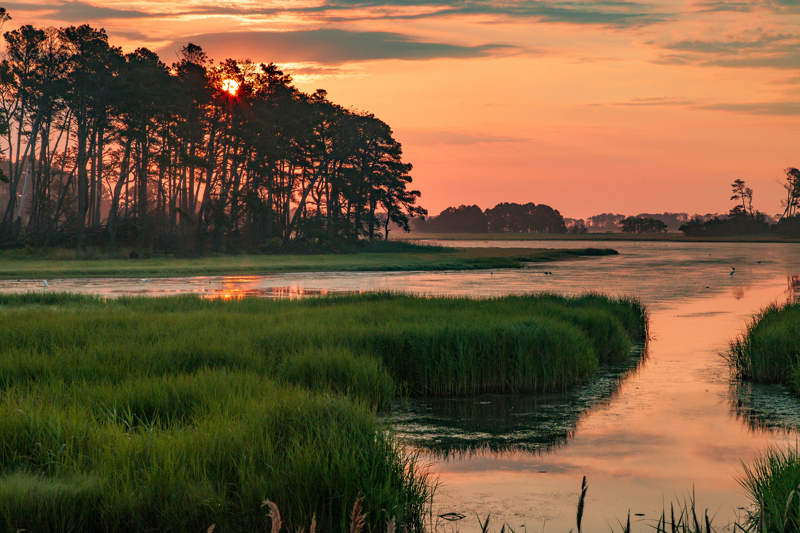
Will Political Turmoil Affect Court Proceedings in the First Federal Wetlands Case to be Decided in Virginia After the U.S. Supreme Court’s Landmark Decision in Sackett?
United States v. Chameleon, LLC & Gary V. Layne
Readers of my blog know that I have been following progress of a wetlands case pending in the U.S. District Court in Richmond. The case name is United States v. Chameleon, LLC & Gary V. Layne. No worries if this is your first visit to my blog because the links embedded in this article take you to my earlier articles that will catch you up on all of the earlier developments. You can read those articles by clicking (in sequential order) here and here and here.
Why Chameleon is So Important
The reason I’m paying attention to Chameleon is because wetlands preservation is the central issue in this case. Preserving wetlands provides clean water, prevents erosion, buffers against flooding, and provides wildlife habitat. The price tag for these important benefits is that wetlands preservation interferes with land development, sometimes by even making an entire property “unbuildable”. Relatedly, I am also paying attention to Chameleon because this is the first time in the post-Sackett world that the federal government has brought an enforcement case in Virginia for the purpose of punishing a person who destroyed wetlands distant from the nearest navigable waterbody, but connected to that waterbody through a spider web of ditches, culverts and streams.

Shutterstock: Gorodenkoff
What is Sackett?
Sackett v. U.S. is the U.S. Supreme Court’s landmark decision, decided in mid-2023, that limits the power of federal regulators (EPA and the U.S. Army Corps) to use their Clean Water Act authority to preserve wetlands connected by watercourses of various types to a navigable waterbody. My earlier articles on this blog explain the Sackett case; click here and here to read them. The rule established in Sackett is that the Clean Water Act allows federal regulation of wetlands if they have a “continuous surface connection” to a traditionally navigable waterbody. In Chameleon the wetlands are four miles from the Chickahominy River, the nearest traditionally navigable waterbody. The case, then, is the first time in Virginia where a federal court is called upon to decide whether the lengthy, serpentine, run of minor watercourses, that connect the Chickahominy river to the wetlands owned by Chameleon , amount to a “continuous surface connection”.
Federal and State Control of Wetlands in Virginia
Do not lose sight of the fact that wetlands in Virginia are regulated separately by the federal and the state governments. The Sackett limitation, requiring the predicate “continuous surface connection”, constrains the federal government but not the state. Virginia regulates wetlands at the state-level under the authority of the Tidal Wetlands Act of 1972 (Va. Code §§28.2-1300 to 1320) and the Virginia Nontidal Wetlands Act, which amends the State Water Control Law (Va. Code §§62.1-44.15:20 to 44.15:23.1). If Chameleon, LLC and Mr. Layne manage to win the federal case now pending against them they could face state-level enforcement if, that is, Virginia has appetite to pursue them.
Case Status at the Time of My Last Update
In my last Chameleon case update the government filed its amended complaint after the defendants (i.e. Chameleon, LLC and Mr. Layne) persuaded the court that the initial complaint was defective. The defendants attacked the amended complaint by filing another Motion to Dismiss, the government filed its brief opposing the Motion to Dismiss, and we were awaiting the defendant’s “reply brief”. The defendants had also filed a motion to halt all proceedings in the case other than actions the Court needs to take to reach a decision on the Motion to Dismiss that the defendants aimed at the Amended Complaint. I placed hyperlinks in my last Chameleon case update for the Amended Complaint, the Defendants’ Motion to Dismiss the Amended Complaint, the Defendants’ Brief in Support of Their Motion to Dismiss the Amended Complaint, the Government’s Brief Opposing the Motion to Dismiss the Amended Complaint, and the Defendants’ Brief Supporting their Motion to Stay the Proceedings.

Shutterstock: Paul Brady Photography
The New Court Filings in the Case
The rules of court allow the defendants to file the final brief supporting their Motion to Dismiss the Amended Complaint (click here to read).
Regarding the Defendants’ Motion to Stay the Proceedings, the government recently filed its Brief Opposing the Motion to Stay (click here to read), after which the defendants filed their Reply Brief in Support of their Motion to Stay (click here to read).
Both of the Defendants’ motions are now ripe for the Court to decide them. Typically, the Court renders its decision after it has held a hearing on the motions. Surprisingly, given this Court’s reputation for prompt action, no hearings are scheduled right now.

Shutterstock: icemanphotos
Political Turmoil Outside the Courtroom
The 2024 Presidential election ushered in a new President in late January, at about the midpoint in the briefing cycle of the two motions. Stability, which has always been a hallmark of the American government and its legal system, has not been the same since the Presidency changed hands in late January of this year.
More than 100,000 federal employees summarily lost their jobs, affecting all parts of the U.S. Government. This type of purge has never happened before. It is happening so quickly, in such haphazard fashion, with little transparency, and no sense of order. This wrecking ball approach is affecting operations in all departments of the federal government. Massive new personnel cuts are announced weekly, even daily
The attorneys representing the United States in the Chameleon case come from the U.S. Department of Justice. They work in the Environment and Natural Resources Division, or “ENRD”. Not surprisingly, ENRD is affected by the unprecedented chaos. The new administration peremptorily eliminated at least one entire section within ENRD. It reshuffled ENRD attorneys, including Section Heads with supervisory responsibility for wetlands enforcement cases. Attorneys with experience spanning 40 years have been shown to the door. Court records in the Chameleon case indicate that an ENRD attorney representing the U.S. in the case is no longer employed at ENRD as of early this month (although the circumstances of her departure are not known).
On the policy front, the new administration last week issued new guidance instructing the EPA and the U.S. Army Corps of Engineers regulators with responsibility for wetlands law enforcement to adopt a narrowed interpretation of the key issue before the Court in Chameleon, namely “continuous surface connection”. (Click here to see EPA’s March 12, 2025 Memorandum to the Field . . . Concerning Proper Implementation of “Continuous Surface Connection” Under the Definition of “Waters of the United States” Under the Clean Water Act.)
Federal Courts are ruling against many of the new administration’s initiatives. Most concerningly, the White House is toying with the option of ignoring the Court rulings that it does not like and is calling for the impeachment of Federal Judges who issue those rulings, drawing rebuke from the Chief Justice of the United States.
Some wonder how the Chameleon Court will move the legal proceedings ahead in the midst of such disorder and turmoil. Given this Court’s nationwide reputation for prompt decisions, it is noteworthy and indeed surprising that it has not yet set a hearing date for the two motions before it in Chameleon that have been fully briefed and ripe for decision for more than 30 days.
Stay tuned for further updates.
Conclusion
I and the attorneys with whom I work have strong connections and significant legal experience. As you can tell from the time a few years ago when I stripped off my shoes and got in the water to fend off a criminal enforcement action that an environmental regulator threatened against my client, I go the extra mile to protect our clients, if that is what is needed to get the job done.
Contact me if you would like me to publish more articles on wetlands law. Of course, you can always contact me for advice and assistance in connection with other needs specific to your particular situation.
